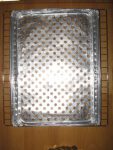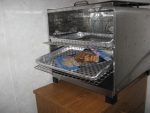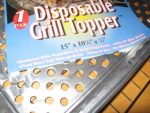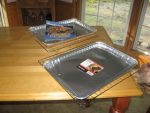Hugh,
I’ve noticed a couple of letters from people writing in and asking about the problem of smaller veggies falling through the trays with the tier-style hydrators. I wrestled with the same issue in the beginning and started out by using aluminum foil stretched across the racks. That proved to be impractical for long-term usage because each time you moved the rack in or out of the dryer the edges of the foil would catch on the sides and tear, not to mention the trick of getting them into the dryer without everything falling all over the floor. Additionally the veggies would stick to the aluminum foil. It was pretty time consuming just getting the food off without all kinds of little pieces of foil stuck to the food, so that technique ended up being basically a one-time thing, as you had to put new foil on all of the racks with every new batch. After that, I began molding the aluminum foil into cookie sheets. That solved the tearing problem but not the sticking issue. Finally the light went on.  After a good bit of searching I found two styles of what I call throw-away cookie sheets at the dollar store. The perforated pans are actually throw-away pans for grilling veggies on the grill. You get a set of two for $2.00 (a dollar a piece). I have a ten-rack dehydrator so it cost me ten bucks for a set. They work great. There is very little sticking, and they’re heavy enough to be able to scrape stuck-on food without tearing. I use a steel spatula for this, but the sticking issue really only happens with the mixed veggies, peas, carrots, and corn. I use the perforated sheets for better air circulation on things like broccoli, cauliflower, zucchini, squash, diced potatoes, mushrooms, and onions. All of these just slide right off after drying. There’s no sticking whatsoever. The non-perforated pans are used for the frozen mixed veggies from the store, corn off the cob, and peas. One note of caution about either of these styles: Don’t use even the perforated pans for any kind of fruit. The sugar glues the food to the pans. I’m talking Super-Glue! I always put fruit, no matter how small, directly on the racks themselves. Maybe I should have included this as another learning-curve take-away in the article.
After a good bit of searching I found two styles of what I call throw-away cookie sheets at the dollar store. The perforated pans are actually throw-away pans for grilling veggies on the grill. You get a set of two for $2.00 (a dollar a piece). I have a ten-rack dehydrator so it cost me ten bucks for a set. They work great. There is very little sticking, and they’re heavy enough to be able to scrape stuck-on food without tearing. I use a steel spatula for this, but the sticking issue really only happens with the mixed veggies, peas, carrots, and corn. I use the perforated sheets for better air circulation on things like broccoli, cauliflower, zucchini, squash, diced potatoes, mushrooms, and onions. All of these just slide right off after drying. There’s no sticking whatsoever. The non-perforated pans are used for the frozen mixed veggies from the store, corn off the cob, and peas. One note of caution about either of these styles: Don’t use even the perforated pans for any kind of fruit. The sugar glues the food to the pans. I’m talking Super-Glue! I always put fruit, no matter how small, directly on the racks themselves. Maybe I should have included this as another learning-curve take-away in the article.
The size of the pans in the pics is ¾” x 10-3/8 x 15”. (Those are inside dimensions.) This was the closest size I found to matching the rack size. Being a little wide as they were for mine, you may have to fold two of the edges up and then squash the corners flat with a pair of pliers for a nice flat fit in the dehydrator. But after that’s done they slide in and out nicely.
After about six or seven uses, they will get a bit of the grunge factor working from the sugar in the veggies. This is what causes the corn and peas to stick. I have cleaned them by both soaking in the bath tub and then washing with soap, and also by using a Brillo pad followed with a soaping. Soaking first works the best. The bits and pieces of food that are stuck rehydrate and just float off. Then all that’s needed is a soaping. They last forever it seems. I have a set of each type in reserve and am currently only on my second set after using this system for years. I really liked the non-stick pads that your wife found. Will definitely be looking into those.
I have always avoided using any kind of vegetable sprays in dehydrating because of the rancidity factor. For shorter-term storage and usage, sprays may not make any noticeable difference at all, but if you’re shooting for maximum long-term storage years I don’t think I would recommend it. I can’t speak with absolute authority here because I haven’t done a side-by-side test of something that has been stored for say five years; one with pans sprayed with oil, the other not. But the reason I shy away from this concept is I remember when I was doing research on dehydrating hamburger, many of the videos and articles stressed over and over again that the better the meat was rinsed of the fat the longer it would store before turning rancid. It was the amount of residual oil that determined shelf-life; oil eventually goes rancid. I have some that has been in storage for a little over a year now so it might be time for a test.
Lastly, if you do have the cash to spend, Excalibur seems to have the market on this problem we’ve been talking about. Their trays are made of a fine screen which cures the fall-through problem. I can’t speak to the sticking problem as I’ve never owned one of these. Their smallest four-tray units start at around $110 and the different models go all the way up to $1,000 for their stainless steel commercial unit, with many of their nine-tray dryers coming in at around $300, give or take depending on the amenities. And they offer a big selection. But again, keep your eye on Craigslist for a great buy on used! – M.P.












